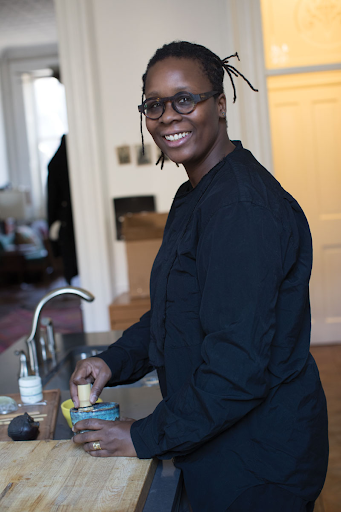ART
ARTIST MICKALENE THOMAS ON HER NEW WORK AND CREATIVE PROCESS
New York-based artist Mickalene Thomas, best known for her labor-intensive paintings, talks to AS IF Magazine about her new projects.
INTERVIEW
by RONALD SOSINSKI
PORTRAITS
by TATIJANA SHOAN
ALL ARTWORK
by MICKALENE THOMAS
The following conversation took place in New York-based artist Mickalene Thomas’s studio in Brooklyn while she was in the final stages of preparation for her show at the Seattle Art Museum, Figuring History: Robert Colescott, Kerry James Marshall, Mickalene Thomas, which featured three solo shows from the three artists. The conversation focuses on and develops around one specific painting, Portrait of Maya, 2018. We begin with the idea of portraiture and muses, develop the concept of photography as a medium in her practice, and further reach into video and the importance of collage as a fundamental in her work.
AS IF: Let’s discuss your new Portrait of Maya #10.
Mickalene Thomas: It was based on a series of photographs I had taken of Maya [the artists former lover] in our home and basement studio on Lexington Avenue, Brooklyn. What I appreciate about those photographs is they were shot with a 35mm disposable camera, so the quality and resolution were low. The residue and intimacy of the framework reminds me of the nudes in the 70’s. I wondered the one-hour photo thought of those resique images as they processed them.
They’re extremely intimate as if they’re voyeuristic, and they feel like they had been clipped out of a porn magazine.
Not porn, beautiful nudes, like the Jet Beauties of the week! I started working with photography in early 2000, as a tool for my paintings to formalize my compositions and have material to reference. It didn’t matter to me that I was developing my photos at a one-hour photo. I’ve now upgraded my photographic process and taken it seriously by using more sophisticated cameras. My photographs can stand alone and no longer are references for my paintings. I’m having fun experimenting with different photographic techniques. In Maya #10 I used Photoshop to enhance this sense of movement by layering several photos of Maya. I’m interested in the types of compositional techniques that create a depth of field or visual illusion; juxtaposing the painted elements with photographic elements.

Mickalene Thomas at her home in Brooklyn by Tatijana Shoan
I love the contrast from early Maya, to Maya now. Your earliest work always had beads, and the photo has developed a three-dimensional element visually.
Absolutely. I was thinking about Duchamp’s “the nude descending the staircase, No.2” I appreciate how he is using constructed modes of abstraction by assembling the painting elements to suggest rhythm and movement within the figure. In my case I’m using photographic elements to create rhythm and movement. I’m interested in the relationship between the two-dimensional and the three-dimensional; for example, the way the eye may initially perceive the painting as a two-dimensional image, but an additional layer is physically added with the rhinestones. This idea is taken even further in Maya #10. The figure is standing almost monumentally, looking down at the viewer and commanding the space with her arms raised behind her head like wings spread. I try to select my materials so that the paintings appear transformative; I’m conveying strength, beauty, power and vulnerability.
All your work is narrative, and I love the idea of painting as a short film.
My videos and films definitely support my painting practice as narrative short films. I dabbled in video during undergrad, but I didn't start really experimenting with video until late 2008, just before my first solo show with Lehmann Maupin She’s Come UnDone!. I worked on a video series called Ain’t I A Woman. I would set up a video camera while I was shooting. I remember with one particular model, Carrie, she was doing so many different movements that were too fast to actually capture because I was using a medium format camera, but what’s exciting to see is how it was caught on film.

